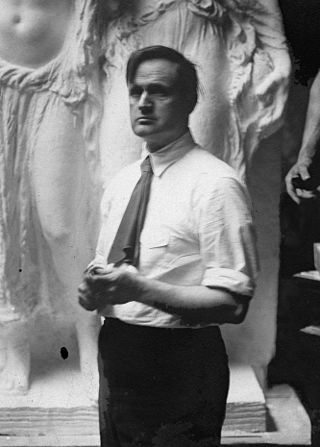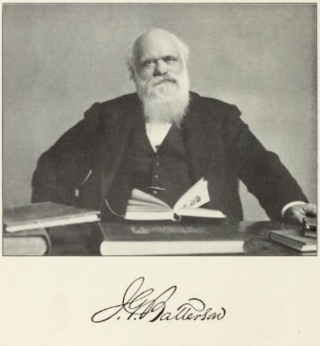Related Research Articles

Jean-Antoine Houdon was a French neoclassical sculptor.

George Grey Barnard, often written George Gray Barnard, was an American sculptor who trained in Paris. He is especially noted for his heroic sized Struggle of the Two Natures in Man at the Metropolitan Museum of Art, his twin sculpture groups at the Pennsylvania State Capitol, and his Lincoln statue in Cincinnati, Ohio. His major works are largely symbolical in character. His personal collection of medieval architectural fragments became a core part of The Cloisters in New York City.

Lee Oscar Lawrie was an American architectural sculptor and a key figure in the American art scene preceding World War II. Over his long career of more than 300 commissions Lawrie's style evolved through Modern Gothic, to Beaux-Arts, Classicism, and, finally, into Moderne or Art Deco.

Daniel Chester French was an American sculptor of the late nineteenth and early twentieth centuries. He is best known for his 1874 sculpture The Minute Man in Concord, Massachusetts, and his 1920 monumental statue of Abraham Lincoln in the Lincoln Memorial in Washington, D.C.
Adolph Alexander Weinman was a German-born American sculptor and architectural sculptor.

Karl Theodore Francis Bitter was an Austrian-born American sculptor best known for his architectural sculpture, memorials and residential work.

Alexander Stirling Calder was an American sculptor and teacher. He was the son of sculptor Alexander Milne Calder and the father of sculptor Alexander (Sandy) Calder. His best-known works are George Washington as President on the Washington Square Arch in New York City, the Swann Memorial Fountain in Philadelphia, and the Leif Eriksson Memorial in Reykjavík, Iceland.

Lorado Zadok Taft was an American sculptor, writer and educator. His 1903 book, The History of American Sculpture, was the first survey of the subject and stood for decades as the standard reference. He has been credited with helping to advance the status of women as sculptors.

Charles Allan Grafly, Jr. was an American sculptor, and teacher. Instructor of Sculpture at the Pennsylvania Academy of the Fine Arts for 37 years, his students included Paul Manship, Albin Polasek, and Walker Hancock.

James Earle Fraser was an American sculptor during the first half of the 20th century. His work is integral to many of Washington, D.C.'s most iconic structures.

Alexander Phimister Proctor was an American sculptor with the contemporary reputation as one of the nation's foremost animaliers.

Charles Henry Niehaus was an American sculptor.

Bela Lyon Pratt was an American sculptor from Connecticut.
Edmond Romulus Amateis was an American sculptor and educator. He is known for garden-figure sculptures, large architectural sculptures for public buildings and portrait busts.

James Goodwin Batterson was an American designer and builder, the owner of New England Granite Works from 1845 and a founder in 1863 of Travelers Insurance Company, both in Hartford, Connecticut. He introduced casualty insurance in the United States, for which he was posthumously inducted into the Insurance Hall of Fame (1965).

Heurich Mausoleum is a public artwork by sculptor Louis Amateis, located at Rock Creek Cemetery in Washington, D.C., United States. "Heurich Mausoleum" was originally surveyed as part of the Smithsonian's Save Outdoor Sculpture! survey in May 1993. This sculpture is the final resting place of members of the Heurich family.
Louis Saint-Gaudens was a significant American sculptor of the Beaux-Arts generation. He was the brother of renowned sculptor Augustus Saint-Gaudens; Louis later changed the spelling of his name to St. Gaudens to differentiate himself from his well-known brother.

Henry Jackson Ellicott was an American sculptor and architectural sculptor, best known for his work on American Civil War monuments.

Charles Eugene Tefft was an American sculptor born in Brewer, Maine. His statue of Hannibal Hamlin is one of Maine's two statues in the National Statuary Hall Collection located in the US Capitol in Washington D.C. A second Tefft statue of Hamlin stands in Norumbega Mall in downtown Bangor, Maine.

Bruno Louis Zimm was an American sculptor. He created a variety of works: fountains, memorials, freestanding sculptures, and architectural sculptures.
References
- ↑ Opitz, Glenn B., Mantle Fielding's Dictionary of American Painters, Sculptors & Engravers, Apollo Books, Poughkeepsie, NY, 1988
- ↑ "Prof. Louis Amateis Dead" (PDF). New York Times. 19 March 1913. Retrieved 21 December 2010.